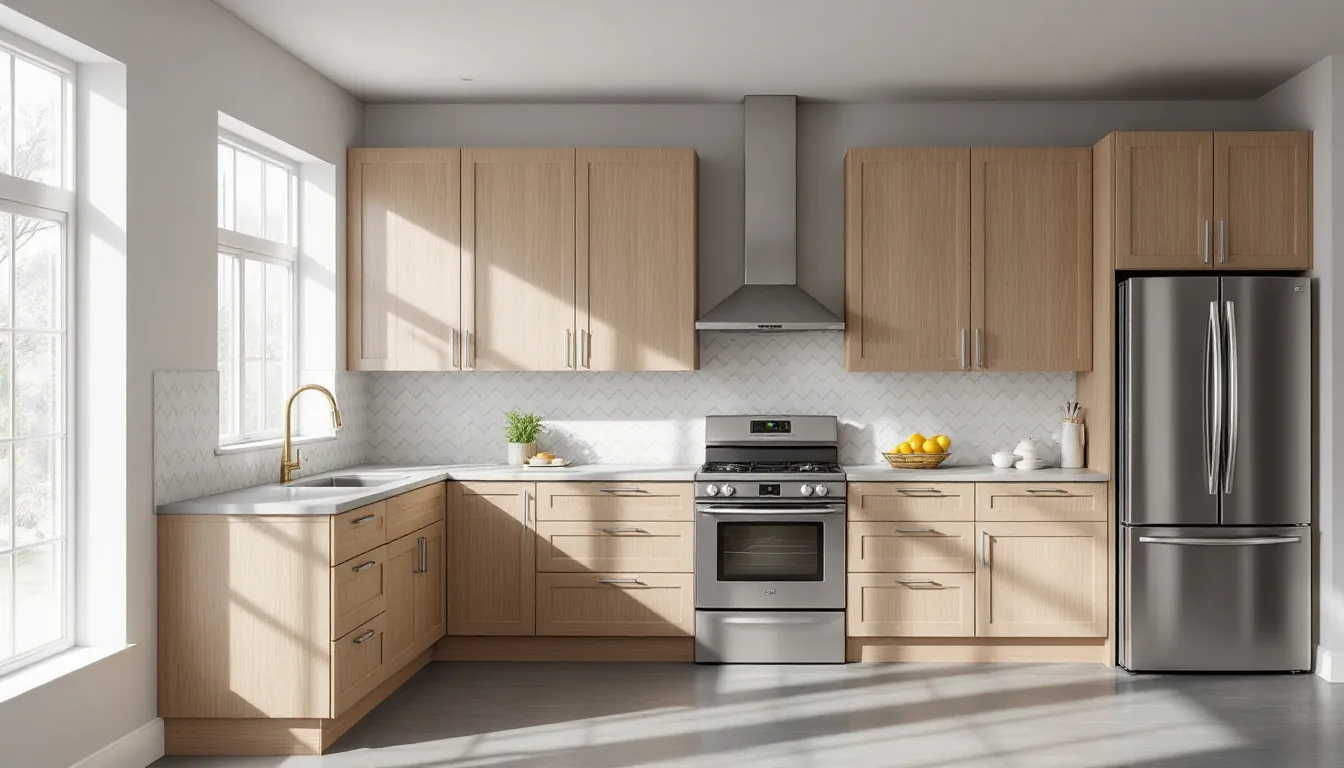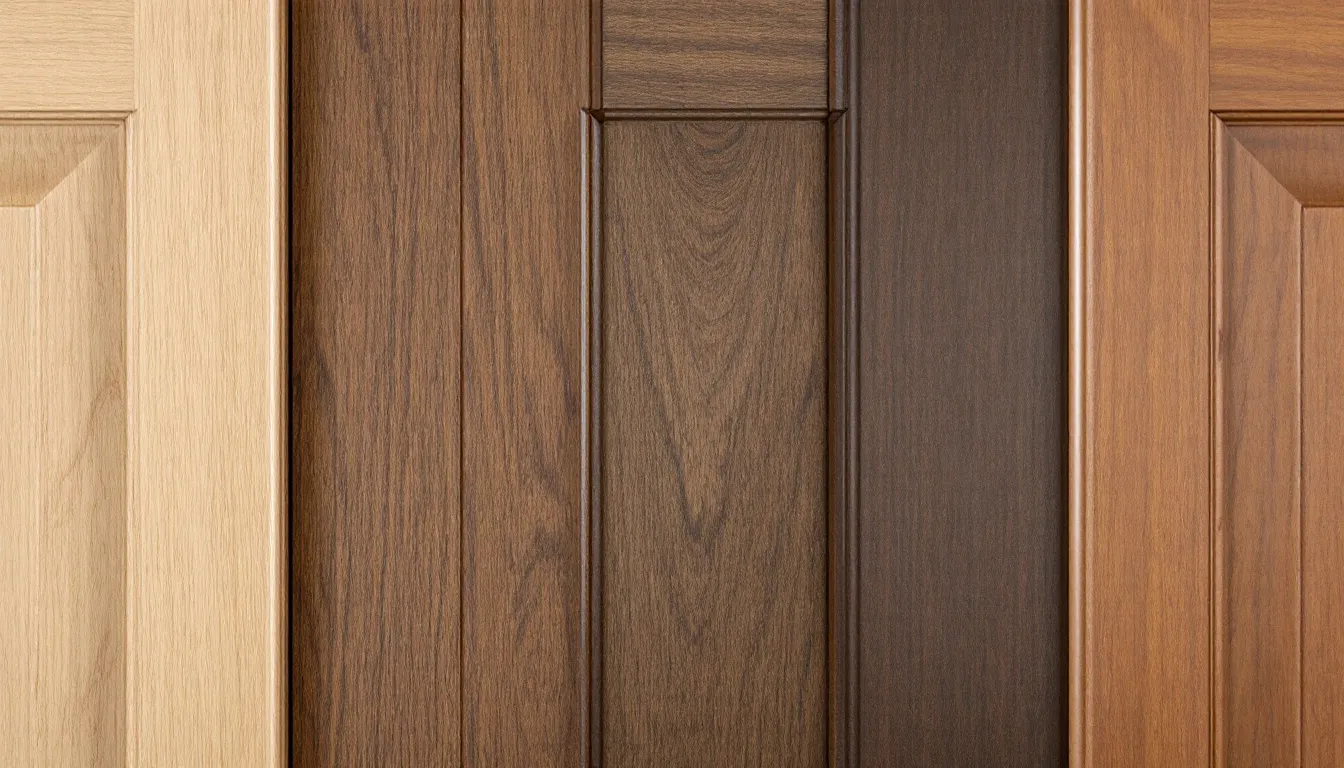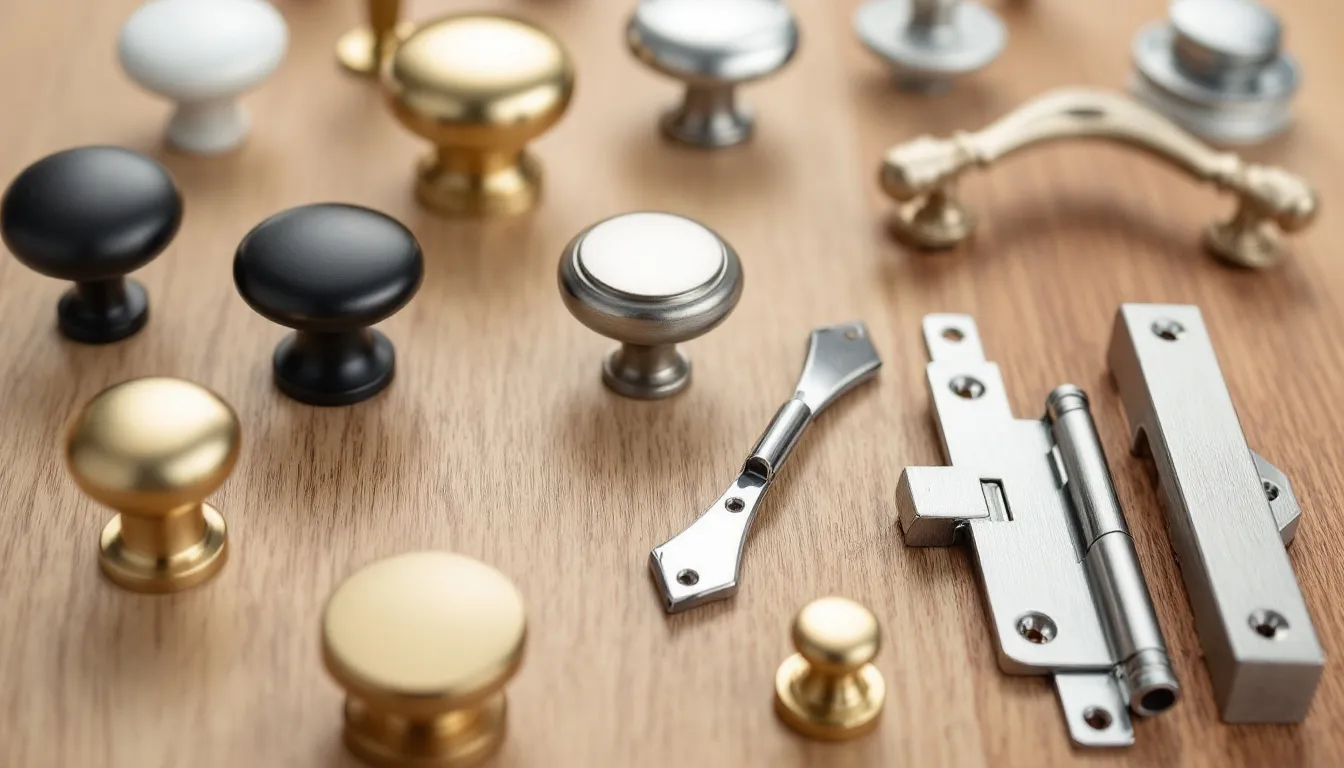The kitchen cabinet landscape has experienced a seismic shift that’s catching even seasoned designers by surprise. After a decade of white cabinet dominance, homeowners are finally ready for something different, and the results are reshaping kitchens across the country. From the dramatic fall of all-white kitchens to the rise of multi-toned cabinetry, 2024-2026 represents one of the most dynamic periods in kitchen design history.
Whether you’re planning a complete kitchen remodel or simply looking to update your existing space, understanding these emerging kitchen cabinet trends will help you create a dream kitchen that’s both current and timeless. This comprehensive guide will walk you through the hottest trends, practical selection advice, and budget-smart ways to transform your kitchen into a space that truly reflects your style. It will also help you decide on the best kitchen cabinet trends and styles to suit your needs.
Introduction to Cabinet Styles
When it comes to designing your dream kitchen, the style of your kitchen cabinets sets the tone for the entire space. Cabinets are not just storage—they’re a major design element that can transform the look and feel of your kitchen. Whether you’re drawn to the clean lines of modern styles, the timeless charm of traditional cabinetry, or the balanced appeal of transitional designs, there’s a cabinet style to fit every aesthetic and lifestyle.
Designers recommend starting by considering your family’s needs, the size of your kitchen, and your personal taste. The type of wood you choose, the stain or finish, and the hardware all play a crucial role in creating a cohesive kitchen design. For example, sleek hardware and a light wood stain can give cabinets a modern edge, while ornate handles and rich woods like cherry or walnut can create a more traditional atmosphere.
By understanding the characteristics of different cabinet styles, you can make informed choices that not only look beautiful but also enhance the functionality of your kitchen. The right cabinets will help you create a space that’s both inviting and practical, perfectly tailored to your family’s needs and your home’s overall design.
Assessing Your Space
Before you start choosing cabinet styles, it’s important to take a close look at your kitchen’s space and layout. Begin by measuring your kitchen carefully, noting the placement of appliances, windows, doors, and any architectural features that could impact your cabinet configuration. The size of your family and how you use your kitchen will also influence your decisions—larger families often need more storage, while smaller kitchens benefit from efficient cabinet solutions that maximize every inch.
Think about how your cabinets will interact with other elements in your kitchen, such as the color of your walls, the style of your flooring, and the finish of your appliances. Choosing cabinets that complement these features will help create a harmonious and beautiful kitchen design. Don’t forget to consider the flow of the space—well-placed cabinets can make your kitchen more functional and enjoyable to use.
By thoroughly assessing your space, you’ll be able to select cabinet styles and configurations that not only fit your kitchen perfectly but also enhance its overall aesthetic and efficiency.
Planning Your Dream Kitchen
Creating your dream kitchen starts with thoughtful planning. Think about how you use your kitchen every day—do you love to cook elaborate meals, or is your kitchen more of a gathering spot for family and friends? Your lifestyle and cooking habits should guide your choices when it comes to cabinet features, storage solutions, and overall kitchen design.
Consider what’s most important to you: Do you need extra-deep drawers for pots and pans, or specialized storage for dishes and small appliances? Are you drawn to the sleek look of modern cabinets, or do you prefer the warmth of traditional styles? The hardware you choose, from drawer pulls to cabinet knobs, can also make a big impact on the final look and feel of your kitchen.
Take advantage of online kitchen design tools and inspiration galleries to visualize different styles and layouts. These resources can help you experiment with colors, finishes, and configurations before making any final decisions. By planning carefully and considering both form and function, you’ll be able to create a kitchen that’s as beautiful as it is practical—truly the heart of your home.
The Biggest Kitchen Cabinet Trends Reshaping Kitchens in 2024-2026
The most significant shift in kitchen cabinets isn’t just about color—it’s about personality. White cabinets, which held the top spot for over a decade, have dropped from first to third place in popularity as homeowners seek more character and warmth in their kitchens. This dramatic change reflects a broader desire for spaces that feel human and lived-in rather than sterile showrooms.
Light wood stains have emerged as the new number one finish choice, particularly on white oak, creating kitchens that feel both modern and welcoming. These finishes offer the brightness homeowners loved about white cabinets while adding natural warmth and texture that many kitchens were missing.
Multi-toned kitchens featuring 2-5 different cabinet colors are becoming mainstream, allowing families to create zones within their kitchen space. This trend enables homeowners to highlight specific areas—like making the kitchen island a focal point with a bold color while keeping perimeter cabinets in a neutral tone. Generally, this approach is being adopted across a variety of kitchen styles, reflecting a move toward more personalized and flexible design.
When considering color and tone, it’s important to coordinate cabinet colors with the floor to achieve a balanced kitchen aesthetic. Choosing complementary tones for cabinetry and flooring can help create harmony and visual interest throughout the space.
Custom walk-in pantries are replacing formal dining rooms in new builds, with nearly 90% of new construction projects now including dedicated pantry space. This shift reflects how modern families actually live, prioritizing efficient storage and workspace over formal entertaining areas. Another popular trend is to carry cabinets all the way up to the ceiling, maximizing storage and reducing dust accumulation.
Modern traditional style is blending classic proportions with contemporary elements, creating kitchens that feel both timeless and current. Meanwhile, transitional style is declining as homeowners seek more personality and defined aesthetic direction in their kitchen design.

Color Trends: The Death of All-White Kitchens
The fall from grace of white cabinets represents more than just a style shift—it reflects a fundamental change in how we want our kitchens to feel. White cabinets dominated since 2010 because they offered a clean, bright aesthetic that photographs well and seemed safe for resale. However, many homeowners found their all-white kitchens felt cold and sterile, lacking the warmth and character they wanted in their home’s heart.
Light stains on white oak are creating the warm, airy kitchens that homeowners desire without the stark brightness of pure white. These finishes celebrate the natural wood grain while maintaining the light, open feel that made white cabinets so popular. The result is a kitchen that feels both fresh and lived-in.
Off white and cream tones are serving as softer alternatives to pure white, offering the brightness many homeowners want while adding subtle warmth. These colors work beautifully in both traditional and modern kitchen designs, providing versatility that pure white often lacks. It’s important to ensure that these finishes harmonize with the rest of the kitchen’s design elements, such as countertops, backsplashes, and flooring, for a cohesive look.
Industry experts predict that mid-tone stains will overtake light stains by 2027 as homeowners continue moving toward richer, more saturated colors. This shift toward deeper tones reflects a growing comfort with bold choices and a desire for kitchens with more visual weight and presence.
Navy blue, sage green, and charcoal are emerging as popular accent colors, particularly for kitchen islands and lower cabinets. These colors add sophisticated contrast while remaining neutral enough to work with various design styles and color schemes.
The key to using multiple colors successfully lies in maintaining visual harmony. Designers recommend choosing colors from the same family or using the 60-30-10 rule: 60% dominant color, 30% secondary color, and 10% accent color. This approach creates visual interest without chaos. Before making a final decision, always review a sample of your chosen cabinet color or finish in your own kitchen lighting to ensure it complements the space as intended.
Wood Species and Finish Trends
White oak continues maintaining its premium status despite slow growth rates and higher costs, remaining the gold standard for kitchen cabinets. Its tight grain pattern and light natural color make it ideal for both stained and painted finishes, while its durability ensures long-term performance in busy kitchens. White oak slowly develops character and patina over time, further enhancing its premium appeal and sustainability.
Red oak is making a remarkable comeback thanks to improved light stain techniques that minimize the species’ naturally prominent grain patterns. Modern finishing methods can create surprisingly subtle, sophisticated looks that rival white oak’s appeal while offering better value for budget-conscious homeowners.
Walnut and cherry provide rich, sophisticated mid-tone options for homeowners seeking warmth and elegance. These species work particularly well in modern traditional and transitional kitchen designs, offering natural beauty that only improves with age.
Painted finishes are evolving beyond basic white to custom color matches, allowing homeowners to perfectly coordinate their cabinets with their overall design vision. High-quality painted finishes can achieve the same durability as stained wood while offering unlimited color possibilities.
Matte and satin finishes are replacing high-gloss options for easier maintenance and more sophisticated appearance. These finishes hide fingerprints and daily wear better than glossy surfaces, making them particularly practical for busy family kitchens. In contrast, high-gloss or heavily patterned finishes generally require more maintenance to keep looking their best.
Natural grain patterns are being celebrated rather than hidden, representing a significant shift from the uniform, sterile aesthetic that dominated previous years. This trend reflects a broader movement toward authenticity and natural beauty in home design.

Style Evolution: From Farmhouse to Modern Traditional
Farmhouse style has matured beyond shiplap and barn doors into casual, livable elegance that emphasizes comfort and functionality. Today’s farmhouse kitchens feature quality materials, sophisticated color palettes, and refined details while maintaining the relaxed, welcoming atmosphere that made the style so popular.
Modern traditional represents the sweet spot many homeowners are seeking, combining clean lines with classic proportions. This style offers the timeless appeal of traditional design with the simplified maintenance and functionality that modern life demands.
Soft modern features minimal hardware and sleek profiles while maintaining warmth through material choices and color selection. This aesthetic appeals to homeowners who want contemporary style without the cold, industrial feel often associated with ultra-modern design.
Shaker styles remain timelessly popular but with updated proportions and finishes that feel fresh and current. Wider stiles and rails create more substantial door profiles, while new color and finish options keep this classic style relevant for contemporary homes.
Industrial elements like metal accents and exposed hinges are gaining traction, particularly in urban homes and loft-style spaces. These details add visual interest and character while maintaining the clean, uncluttered aesthetic that modern homeowners prefer.
Personalized touches are replacing cookie-cutter design approaches as homeowners seek to create spaces that reflect their individual tastes and lifestyle needs. This trend toward customization ensures that each kitchen feels unique and specifically tailored to its family.
Cabinet Door Trends
Wider stiles and rails on Shaker doors create a more substantial appearance that feels custom and high-end. This proportion adjustment makes standard Shaker doors look more expensive and sophisticated while maintaining the style’s inherent versatility.
Flat-panel doors with subtle texture and grain visibility offer a modern alternative to traditional raised panels. These doors work particularly well with natural wood finishes, allowing the material’s beauty to be the star of the design.
Mixed door styles within the same kitchen create visual interest and functional zones. For example, using glass-front doors on upper cabinets for display while choosing solid doors for storage areas adds both beauty and practicality.
Glass-front uppers are making strategic comebacks in modern designs, particularly for displaying beautiful dishware or creating visual lightness in kitchen design. When used thoughtfully, glass fronts can make kitchens feel more open and spacious.
Hardware and Accent Trends
Brushed brass and warm metals are replacing cool chrome and stainless steel as the preferred finish for cabinet hardware. These warmer tones complement the natural wood finishes and richer colors that are trending, creating a more cohesive and inviting kitchen aesthetic.
Oversized pulls and handles serve both functional and visual purposes, making cabinets easier to use while creating bold design statements. Larger hardware works particularly well with the wider door stiles that are trending, maintaining proper proportional relationships.
Mixed metals within the same kitchen can work beautifully when done thoughtfully, typically involving choosing metals from the same temperature family (all warm or all cool) and maintaining consistent finishes throughout the space.
Integrated pulls and finger pulls offer minimalist aesthetics for homeowners who prefer clean lines and uninterrupted surfaces. These options work particularly well in modern and contemporary kitchen designs where simplicity is paramount.
Black hardware creates dramatic contrast on light cabinets, offering a sophisticated alternative to traditional brass or chrome. This high-contrast approach works particularly well in modern traditional and transitional kitchen designs.
Leather and wood accents provide unique, personalized touches that set kitchens apart from standard installations. These custom details reflect the growing trend toward handcrafted, artisanal elements in home design.

Storage Innovation Trends
Walk-in pantries have become standard in new construction, with studies showing they’re included in 90% of recent projects. These dedicated storage spaces allow homeowners to keep their main kitchen clutter-free while providing ample room for food storage, small appliances, and cleaning supplies.
Butler’s pantries with specialized cabinet storage are gaining popularity among serious cooks and frequent entertainers. These secondary prep areas feature cabinets designed for specific functions—such as serving dish storage, wine displays, or coffee stations—that support the main kitchen’s functionality. Additional storage options in these spaces help maximize available space and keep everything organized.
Hidden appliance garages keep counters clutter-free by providing dedicated cabinet space for small appliances. These storage solutions allow homeowners to maintain clean, uncluttered workspace while keeping frequently used items easily accessible.
Pull-out organizers and drawer systems maximize cabinet interior space, making storage more efficient and items more accessible. These innovations greatly improve accessibility and make it easier to arrange kitchenware efficiently, ensuring that dishes, gadgets, and small appliances are always within easy reach. These systems transform deep cabinets into organized, functional storage that actually gets used rather than becoming black holes for forgotten items.
Charging stations and tech integration built into cabinetry address modern families’ connectivity needs while maintaining clean aesthetics. These features often include built-in power outlets, USB ports, and dedicated device storage that keeps technology organized and accessible.
Coffee and beverage stations with dedicated cabinet storage create specialized zones for morning routines and entertaining. These areas typically feature cabinet storage for mugs, specialty glasses, and beverage supplies, along with space for coffee makers and other appliances.
When installing new storage solutions, putting cabinets and organizers in the right place is crucial for optimal function and accessibility. The process of purchasing additional storage solutions, such as racks or panels, allows you to customize your kitchen organization to fit your needs. Thoughtful purchasing decisions when selecting these storage solutions will help ensure long-term satisfaction and value.
Customization Options
One of the greatest advantages of today’s kitchen cabinets is the wide range of customization options available. Whether you’re working with stock, semi-custom, or fully custom cabinets, you can tailor every detail to fit your needs and style. Choose from a variety of woods and stains to achieve the perfect tone and texture, and select hardware that complements your overall kitchen design.
Modern features like soft-close drawers and doors, adjustable shelving, and pull-out pantries can make your kitchen more functional and enjoyable to use. Customization doesn’t stop at appearance—think about how you want your cabinets to work for you. Do you need extra-deep drawers for cookware, or specialized storage for baking sheets and spices? Working with a designer or contractor can help you create a cabinet plan that maximizes your space and meets your unique requirements.
Whether your vision is a sleek, modern kitchen or a cozy, traditional space, customization options allow you to create cabinets that are a perfect fit for your home and lifestyle. With the right choices, your kitchen will not only look stunning but also function beautifully for years to come.
How to Choose the Perfect Cabinet Style for Your Home
Selecting the right cabinet style requires careful consideration of your family’s specific needs and lifestyle. Start by assessing your storage requirements and cooking habits—families who cook frequently need different organizational solutions than those who primarily reheat prepared foods.
Consider your home’s architectural style and existing features when choosing cabinet designs. A Victorian home might look odd with ultra-modern slab doors, while a contemporary house could feel disconnected with overly ornate traditional cabinets. The goal is creating harmony between your cabinets and your home’s character.
If you need guidance, many companies offer additional help, such as free planning services or inspiration sessions, to support homeowners in making the best choices. You can also meet with a designer for a free consultation to get personalized advice tailored to your space and preferences.
Plan for approximately 24 square feet of cabinets per family of four, adjusting this baseline based on your specific storage needs and cooking habits. This calculation helps ensure adequate storage without over-building your kitchen.
Evaluate your budget for stock, semi-custom, or custom options early in the planning process. Stock cabinets offer limited styles but lower costs, semi-custom provides more flexibility at moderate price points, and custom cabinetry offers unlimited possibilities at premium prices.
Think long-term about style longevity and resale value when making cabinet decisions. While trends are fun to follow, your cabinets will likely remain in your kitchen for 15-20 years, so choosing elements with lasting appeal is wise.
Balance current trends with timeless design principles by incorporating trendy elements in easily changeable details like hardware and paint colors while keeping major structural elements more classic.
Matching Cabinets to Your Lifestyle
Busy families should prioritize easy-clean finishes and smart storage solutions that support their hectic schedules. Matte finishes hide fingerprints better than glossy surfaces, while well-designed drawer organizers keep essentials accessible and organized.
Serious cooks need specialized storage and workspace organization that supports their culinary pursuits. This might include dedicated spice storage, knife drawers, appliance garages, and prep area organization that makes cooking more efficient and enjoyable.
Entertainers want open, accessible layouts with serving areas that support their social lifestyle. This often means incorporating display storage for beautiful dishware, wine storage, and easy flow between kitchen and dining areas.
Empty nesters can downsize their storage needs while maintaining quality and style, often choosing higher-end finishes and details that they might have avoided with young children in the home. This life stage often allows for more investment in luxury features and sophisticated design choices.
Budget-Smart Ways to Embrace Current Trends
Updating hardware and pulls offers the most dramatic style refresh for the smallest investment, typically under $500 for an average kitchen. Choose hardware that reflects current trends while complementing your existing cabinet style and color.
Adding a kitchen island in trending colors provides a focal point without requiring full kitchen renovation. Islands can be purchased as furniture pieces or built custom, offering flexibility in both style and budget.
Painting existing cabinets in on-trend colors like sage green or navy blue transforms your kitchen’s appearance at a fraction of replacement cost. Proper preparation and quality paint ensure professional-looking results that last.
Installing under-cabinet lighting highlights wood grain and adds both functionality and ambiance to your kitchen. LED strips are energy-efficient and create dramatic visual impact while improving task lighting.
Adding open shelving or glass fronts to select upper cabinets creates visual interest and display opportunities without major construction. This update works particularly well for showcasing beautiful dishware or adding personality to your kitchen design.
Incorporating trending colors through backsplash and accessories allows you to experiment with bold choices without major commitment. These elements can be changed more easily than cabinets, making them perfect for testing trend waters.
Future-Proofing Your Cabinet Investment
Choose quality construction that will last 20+ years by investing in solid wood or high-quality plywood construction with proper joinery techniques. Quality cabinets are a long-term investment that should outlast multiple style cycles.
Select versatile base colors that work with changing accent colors and design trends. Neutral wood tones and classic paint colors provide flexibility for updating your kitchen’s look through accessories and smaller design elements.
Invest in good bones with timeless proportions rather than trendy details that may date quickly. Classic door styles and well-proportioned frames will look appropriate longer than highly stylized designs.
Plan electrical and plumbing rough-ins for future tech integration during initial construction or renovation. This foresight allows for easier updates as smart home technology continues evolving.
Avoid ultra-trendy details in major cabinet elements, saving bold choices for easily changeable features like hardware, lighting, and accessories. This approach allows you to follow trends without compromising your investment’s longevity.
Work with experienced designers who understand lasting design principles and can help you distinguish between worthwhile trends and passing fads. Before finalizing your cabinet investment, review design options and customer feedback to ensure you’re making the best long-term choice. Professional guidance helps ensure your cabinet investment serves you well for years to come.
Common Trend Mistakes to Avoid
Following every trend without considering your home’s architectural style creates disconnected, incoherent design that feels forced rather than natural. Choose trends that complement your home’s character and your personal aesthetic preferences.
Choosing ultra-trendy colors for major cabinet investments can result in expensive regret when styles change. Save bold color experiments for smaller, more changeable elements while keeping major components in versatile, timeless finishes.
Skimping on quality to afford more stylish options often results in cabinets that look dated quickly and perform poorly over time. Quality construction with classic styling typically ages better than trendy designs with poor craftsmanship.
Ignoring maintenance requirements of trendy finishes can lead to buyer’s remorse when beautiful cabinets become difficult to keep clean and attractive. Consider your household’s cleaning habits and time availability when choosing finishes.
Not planning adequate storage for your actual needs creates beautiful but dysfunctional kitchens that don’t serve your family well. Prioritize function alongside aesthetics to create a kitchen that works as well as it looks.
Rushing decisions without seeing samples in your home’s lighting conditions often results in color and finish disappointments. Natural and artificial light significantly affect how cabinet colors and wood tones appear, so always test samples in your actual space.
The world of kitchen cabinet trends offers exciting possibilities for creating a space that truly reflects your family’s style and needs. From the dramatic shift away from all-white kitchens to the embrace of natural wood tones and multi-colored designs, today’s options provide unprecedented opportunity for personalization.
Remember that the best kitchen cabinets blend current style with lasting quality, creating a space that serves your family well for years to come. Whether you choose to embrace bold color trends or stick with timeless wood finishes, focus on quality construction, thoughtful storage solutions, and details that reflect your personal aesthetic.
Take time to carefully plan your cabinet choices, considering both immediate appeal and long-term satisfaction. With the right approach, your new kitchen cabinets will provide both the style impact you want today and the enduring beauty you’ll appreciate for decades to come. Start planning your dream kitchen renovation today, and create a space that truly reflects your family’s unique style and functional needs.
Kitchen Cabinet Experts
Want the best quote on re-doing your kitchen? Contact us and let’s look at your project and come up with a plan that fits your budget.
